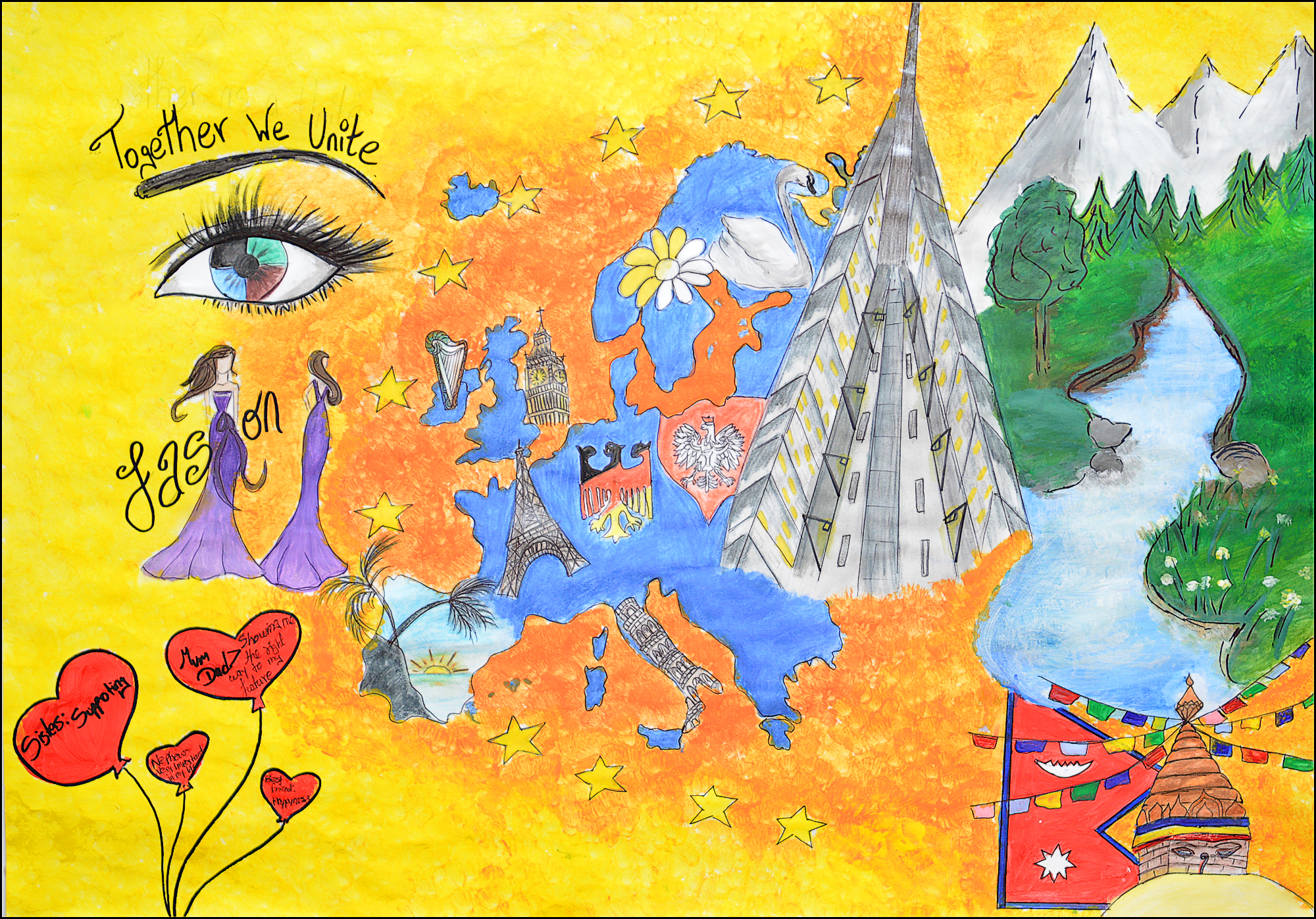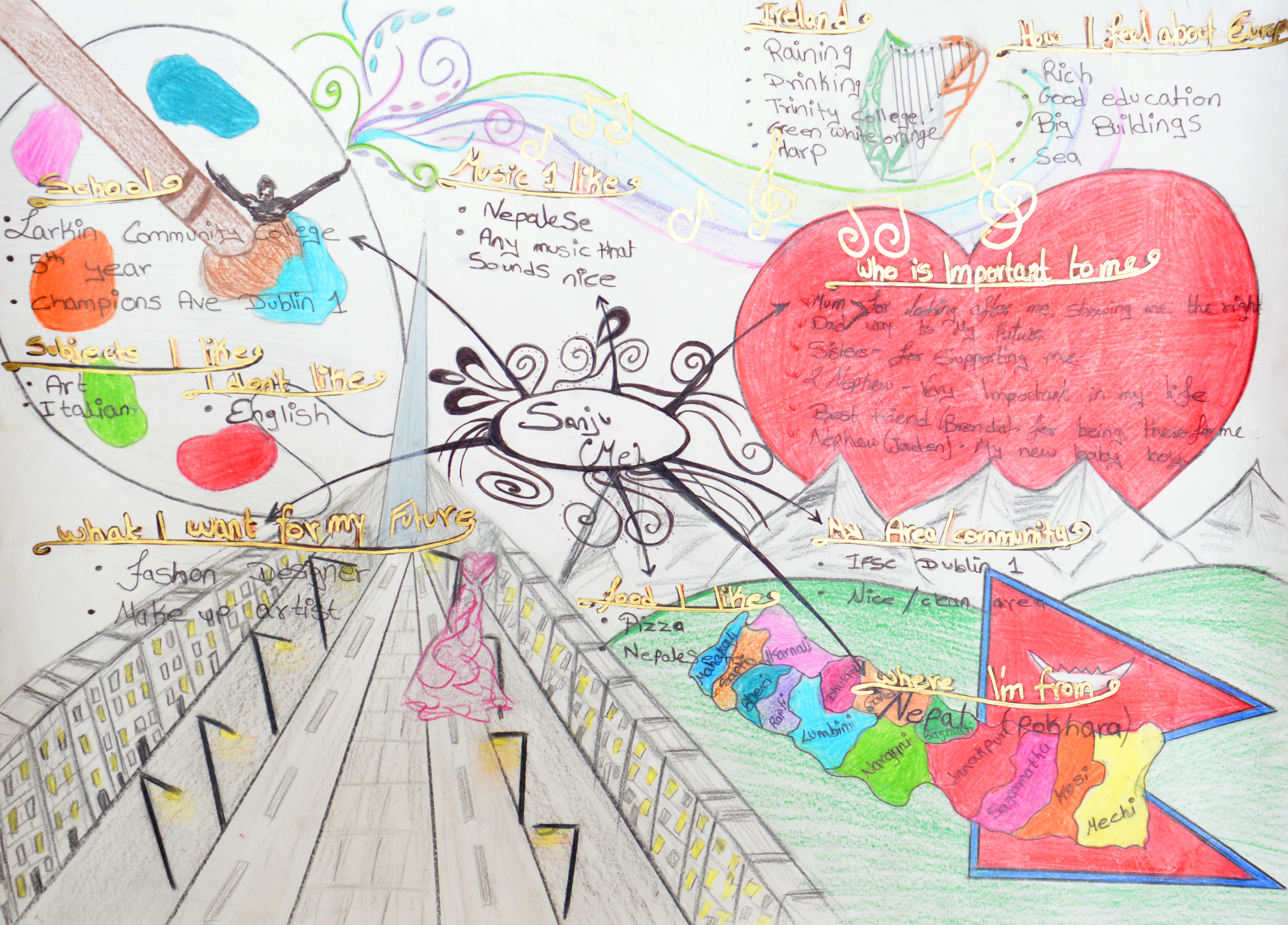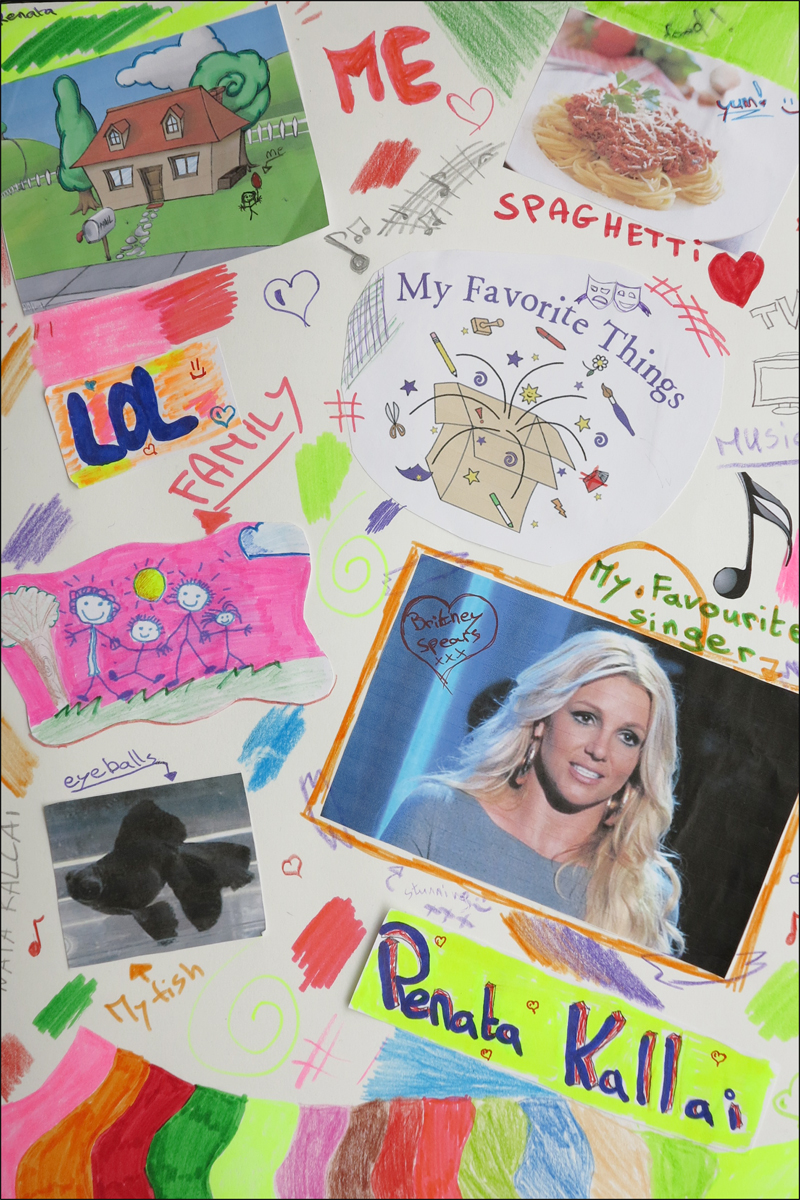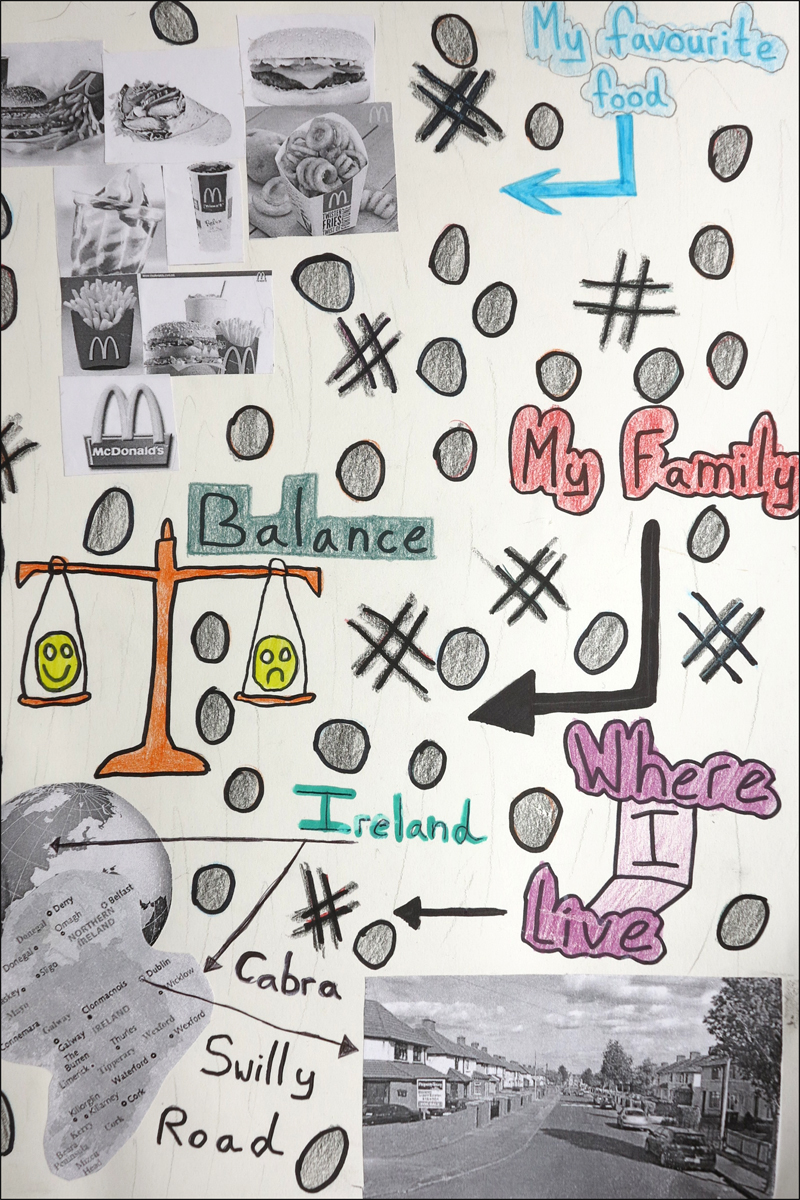Larkin Community College (Secondary School) - Ireland
Region: Dublin
Other schools in the Quad Blog: Utsjoen saamelaislukio (Finland), Zs Palachova (Czech Republic), Ernest Bevin College (UK)
Creative Connections Project: Personal Identity, Irish Identity and European Identity through the Individual, their Community and the European Union
Larkin Community College is a co-educational secondary school (pupils aged 11-18) in an inner city part of Dublin, Ireland. The School is a DEIS school. DEIS stands for Delivering Equality of Opportunity in Schools.
Larkin Community College was opened in 1999 and is an amalgamation of two existing City of Dublin Vocational Education Committee (CDVEC) schools. The school is noted for its Learning through Arts Scholarship Programme; a multidisciplinary cross-curricular arts programme for Junior Cycle students. This programme involves students engaging with facilitators and teachers across a range of arts disciplines with specialisations in Art, Music, Dance and Theatre Making.
Larkin Community College is unusual in that the College attracts students from a wide catchments area (Dublin 1,2,3,7,9,11,33,15,22, and County Dublin). There are 452 students registered to attend the College. The school population is culturally diverse and a small majority of students are of white Irish background. A significant number of students have a first language other than English


The Art Department
The Art ethos in Larkin Community College is strong and encapsulated in the school’s vision to support students to be the best they can be. There are two art teachers and two dedicated Art rooms. One of these rooms is also a pottery room with a large kiln. There also is a dark room for developing photographs available to students. The staff and students have access to a well-stocked library. The library has a full time librarian.
Creative Connections
The Creative Connections team at the school comprised of two teachers, one of whom is an Art teacher and the other a citizenship education teacher who teaches Civic Social Political Education (CSPE). The participating students were in two classes (24 in the Art class and 28 in the CSPE class.)
Both class groups had mixed ability and mixed motivation. The two class groups included:
- Students who were highly motivated academically and intended to go onto third level education
- Students who were motivated and intend on applying for a trade after leaving school
- Students who were breaking new ground as the first in their families to remain in school
- Students who had literacy and numeracy special needs – some already formally defined and identified by the Department of Education and Skills, others not yet identified and / or defined
- Students with chronic absenteeism records
- Students who exhibited challenging behaviour
- Students who were at risk of leaving school early
- Students with chaotic home lives and poor support for their educational development
- Some students with one or more of the above abilities / situations
In both class groups, the teachers’ expectations were initially very positive about the project but sceptical that their students had any real perceptions of a European Identity. The IT component of the Creative Connections project was a concern as there was only one computer in the CSPE classroom and two PCs in the Art room.


An overview of the participant pupils involved
The students from the 2nd year class were studying the compulsory CSPE subject in preparation for their first State Exam at secondary school. The students ranged in ages from 12 – 14. They were a mix of male and female, Irish born and non-Irish born. There were 28 students in the class.
The CSPE lesson was once a week for an hour. All students carry out an Action Project as part of their CSPE curriculum. It is 60% of their final grade. One of the outcomes of this project was that students would develop this Creative Connections project to include a service to the community and write up an Action Project Report afterwards.
Background - Rationale for being involved in the Creative Connections Project
The CSPE teacher and the Art teacher in Larkin College held a strong personal belief in the value of the arts. The CSPE teacher believed that young people can be quite insular in their thinking about being Irish and being non-Irish, and that young people are not aware of what it means to be European. She as a teacher also struggles with Irish identity and European identity and was delighted to be a part of this project to challenge her own perceptions about identity and to learn more, as well as to develop skills that she could use with her students in the classroom. Both teachers have a strong engagement and relationship with the NCAD as host teachers and participants in art and citizenship curriculum projects.
Planning the workshops
Both the Art teacher and the CSPE teacher attended the teacher training days at the National College of Art and Design (NCAD) in October/November 2012. All teachers were given the Images and Identity materials from the Creative Connections website and discussed particular aspects which interested them. The Connected Gallery was also introduced to the teachers as was the digital aspect of the project.
Project Themes
Larkin Community College chose to focus on the topics of ‘Personal Identity, Irish Identity and European Identity through the Individual, their Community and the European Union’. The teachers aimed to generate a debate on Identity (Personal, Irish and European) using visual stimuli and to improve the visual literacy of students through using art works.
The Project in Action
Both teachers used some themes from the Images and Identity lesson plans but in general they designed their lessons themselves and used the images based on Identity from the Connected Gallery. Popular images used were: A Butterfly Girl by Berenika Ovčáčková (a Czech artist), Oracle of O’Connell Street by Sean Hillen amongst others. Both projects were planned to take place over five to six weeks with hour-long classes, but in reality the lessons expanded up to fifteen weeks as the discussion was so rich.
CSPEteacher’s comment:
I think we had started out by saying we would have six lessons. I think I had fifteen lessons done and I was nowhere near finished on the project. I also found I started with my objective in the class and suddenly the conversation is going here and pulling it back.
The learning outcomes for the CSPE lessons were:
- My community / my area and me – a visual response
- My community / my area – my response and other artists' responses to their community
- Developing ownership of my area / my community
- To take ownership of one's own interpretation of an artist's work, to begin to see the tool that visual art can be in helping to articulate identity
- Both teachers dealt with issues of identity (personal, community national and European) in their classes and explored themes of stereotypes, use of symbols through mind maps, questioning and discussion.
- The art works involved drawing, painting, photography and collage
Both teachers felt the value in the project for the students was for the most part in the talking about the art work, articulating their responses and sharing their opinions. Both teachers commented on how they got to know their students better through these discussions.
The Connected Gallery and discussion around national identity:
The art teacher’s comment:
This threw up a lot of questions for them and it started them thinking, so in that way that it is always a good thing because maybe they hadn’t thought about it before so now they will start thinking.
The art teacher found that she got to know her students better and they got to know her through the Creative Connections project.
The teacher’s comment:
I had to do Europe and citizenship and identity and Ireland and find out who they were as a teacher because I don’t...That was really exciting. I got to know them as a class more. They asked me (because I’m from the North of Ireland) - well do you consider yourself Irish - yes I do - But you are from the North of Ireland. I said but what does that mean? - Are you not English?
On European identity the CSPE teacher commented:
We had great discussions about why bother with Europe and what struck me was they hadn’t a clue before we began that the Ireland they know today is because of Europe.
Reflections on the Creative Connections Connected Gallery: finding the students’ voice through contemporary art:
The Creative Connections Connected Gallery proved very positive for both teachers. Both teachers used the artists’ image bank as triggers for conversation in the classroom and found the artwork to have a positive impact on the verbal and visual literacy of their students.
CSPE teacher’s comment:
Creative Connections made me start every class with an image…. one of the problems I think education faces is children’s ability to speak and articulate their opinions and by putting the image up the response was much more forthcoming from the kids.
The art teacher felt it released her from the formal restrictions of the Leaving Certificate art history exam and allowed the students and herself freedom to give a voice to their opinions on contemporary art and their reflections on society. The teachers were surprised at the negative attitude of many students in their discussions on national identity; living in an inner city area meant the students were exposed to many of the current problems of the drug and drink culture on the city streets.
The teacher’s comment:
They were very negative about Ireland as a whole and I was actually shocked because when they came back...they did a mind map on themselves and they did a mind map on Ireland, Europe and possibly where they were from if they were from e.g. the Philippines or Nepal if they weren’t necessarily from Ireland. All the students and I have to say the whole class came back very negative about Ireland. There was drink and drugs, crime…
Reflections on European Citizenship
Both teachers felt the Creative Connections project afforded them a chance to get to know their students through the discussion about identity, although the European aspect was more difficult for the students to grasp. The Irish students had very little sense of European identity apart from their holiday experiences and the non-Irish students were more conscious of what Europe meant for them in terms of bettering themselves through education. Both teachers felt the age of the students impacted on their ability to grasp concepts of citizenship and Europe. The 2nd years struggled; ‘the local Dublin kids weren’t bothered about defining what it is to be European. Most of them said I haven’t a clue”. But the 5th years were more able to understand the abstract concept of European citizenship and the concepts behind some of the art works. The notion of Art as a political tool became clear to both groups through the discussion of art works.
The teacher’s comment
It absolutely became a political tool and the kids found this sense of freedom about expressing how they felt…Do you know the Butterfly Girl? It gave the children a way into their own emotions and I absolutely didn’t expect that.
This aspect of accessing emotion and connectedness through art works was an important finding for this teacher
Quad Blogging
The technology aspect of uploading, blogging and sharing images across countries in the Creative Connections project was considered to be too complex and time consuming for the teachers. They needed a lot of help in managing the logistics of the site. Much of the work happened in the art making process and they simply did not have the time to do all three elements within the time frame; generating discussion with the image bank, making the art work, uploading the art work and blogging as a class with their European partners.
As one teacher said:
If somebody just came in and photographed the students’ work, uploaded and said right, good to go with the students – book a room and let’s go blogging.
As it was, she felt the most important aspect was the discussions centred on Ireland, Europe and Citizenship and the artwork.
As a final comment on the Creative Connections project one teacher says:
I am hungry for this to become something deeper.


